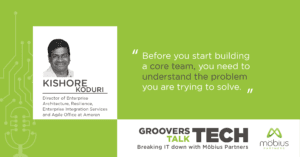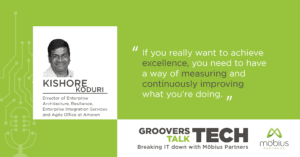Enabling business outcomes is the goal for all IT organizations, but it’s much easier said than done.
Kishore Koduri, Director of Enterprise Architecture, Resilience, Enterprise Integration Services and Agile Office at Ameren, has had tremendous success achieving those outcomes and he shares tips and advice for others on their transformation journey.
Join us as we discuss:
From Concept to Scale
The world is filled with people who have great ideas. With brilliant minds who can come up with brilliant solutions to some of the world’s toughest problems.
But the problem is, you’ve got to be able to not only come up with a solution, but come up with a way to scale that solution to work in a larger setting. To understand innately the problem that you are trying to solve.
Before you start building any core team for anything, you need to intimately understand the problem you are trying to solve. Leaders need to ask questions.

What is the success criteria going to look like? Bring in functional as well as technical people. It’s not all about subject matter experts when you’re building a core team. It’s about having people with good team building skills as well as soft skills.
Diversity is the name of the game when you’re building those core teams.
Transforming an Existing Legacy Monolith Solution
As with most methodologies, it’s all about people, processes, and technology. It all starts with understanding the problem, as we talked about earlier. Knowing where you’re headed. This is the process leg of the stool.
Then once you know that, the agile journey of transforming your existing legacy solution into one that is more efficient, helpful, and that works for everyone.

You need to look into a process from both inside and outside perspectives, then switch to the technology aspects of it. Are you sign the right tools or technologies to solve the problem? Are you using a technology for the sake of that technology, or because it’s the best for the job? Here we’re talking about the technology leg of the stool.
Finally, people.
Everything boils down to the talent and people that you have. You’re only as good as your team. If you haven’t, work with your HR reps to understand how you’re incentivizing your team and your people. Make sure it’s aligned with your company culture.
Doing This at a Fortune 500 Company
Scaled change is never easy, but what makes it even more difficult is trying to implement transformational change at a Fortune 500 company. Because big established companies are typically more hesitant to change.
Why?
For the same reason it’s harder to turn around a cruise ship than it is to turn around a rowboat. The sheer size and scope of the company.
That doesn’t mean it’s not possible though.
It starts with your people. You’re only as good as the people you hire. Then it comes to your guiding principles. Are those guiding principles well understood across the enterprise? Then you formulate a model or a roadmap to get when you want to go.
Still itching for more IT strategy and tactics? You can find this interview and many more by subscribing to Groovers Talk Tech on Apple Podcasts, Spotify, or here.
Listening on a desktop & can’t see the links? Just search for Groovers Talk Tech in your favorite podcast player.
get started today
| Cookie | Duration | Description |
|---|---|---|
| cookielawinfo-checkbox-analytics | 11 months | This cookie is set by GDPR Cookie Consent plugin. The cookie is used to store the user consent for the cookies in the category "Analytics". |
| cookielawinfo-checkbox-functional | 11 months | The cookie is set by GDPR cookie consent to record the user consent for the cookies in the category "Functional". |
| cookielawinfo-checkbox-necessary | 11 months | This cookie is set by GDPR Cookie Consent plugin. The cookies is used to store the user consent for the cookies in the category "Necessary". |
| cookielawinfo-checkbox-others | 11 months | This cookie is set by GDPR Cookie Consent plugin. The cookie is used to store the user consent for the cookies in the category "Other. |
| cookielawinfo-checkbox-performance | 11 months | This cookie is set by GDPR Cookie Consent plugin. The cookie is used to store the user consent for the cookies in the category "Performance". |
| viewed_cookie_policy | 11 months | The cookie is set by the GDPR Cookie Consent plugin and is used to store whether or not user has consented to the use of cookies. It does not store any personal data. |
"*" indicates required fields